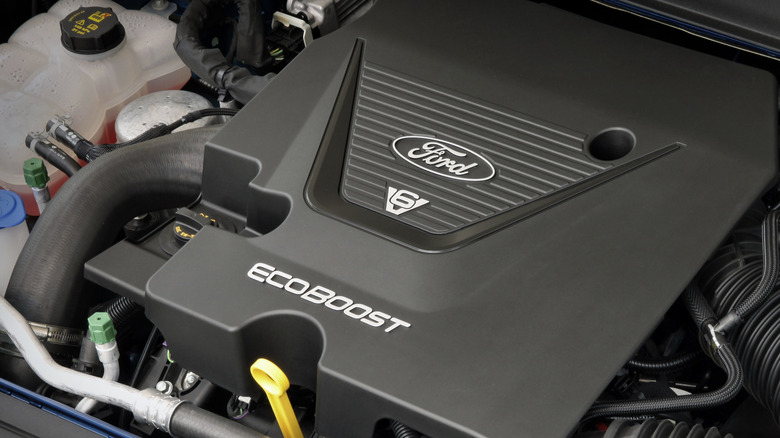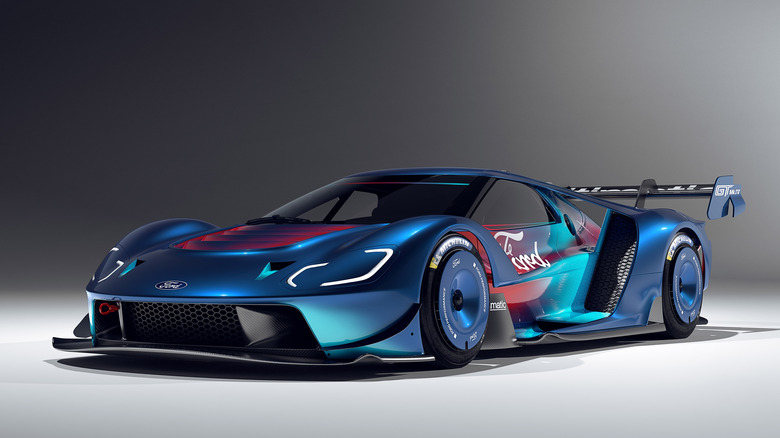Here's What Make Ford's EcoBoost Engines So Special
Traditionally, when an automaker unveils a car made around being as efficient as possible, the results aren't always pulse-pounding. The Toyota Prius is a historic and excellent car and can be credited with popularizing hybrid technology as the world knows it, but it's not going to get speed fanatics excited. In the late 2000s, prior to the advent of incredibly fast electric cars and hybrids, your choices were either a powerful car with poor fuel economy, or a hybrid that sipped fuel, but took its time getting off the starting line. Ford sought to bridge the gap with its EcoBoost line of motors.
The EcoBoost first arrived on the scene in 2009 as a twin-turbocharged 3.5-liter V6, and would later be available in a variety of displacements. More importantly, Ford boasted that the engine would be 20% more efficient than previous Ford powerplants, and it would punch above its weight class in the power department. One of the first notable cars to get the EcoBoost treatment was the 2010 Ford Taurus SHO. Its 3.5-liter EcoBoost motor generated 365 horsepower to all four wheels. For fuel economy, the SHO achieved an estimated 20 miles per gallon. For comparison, a 2010 AWD Dodge Charger RT with a 5.7-liter V8 that produced 368 horsepower got only an estimated 18 combined miles per gallon, losing out to the Taurus.
The boost in EcoBoost
The EcoBoost moniker doesn't apply to any specific engine as the name appeared on several different engines over the years. It's really the name of the technology applied to the engine. According to Ford, EcoBoost technology is comprised of three different parts. First, turbocharging, hence the "Boost" name is the most obvious. Turbocharging, for the most part, is an efficient way to squeeze power from an engine as it puts the exhaust gases to work instead of allowing them to escape from the engine. Second, an EcoBoost engine utilizes direct injection. Direct injection allows fuel injectors to spray fuel into the combustion chamber a lot more precisely and in turn, use less fuel. Lastly, Ford uses twin independent variable camshaft timing to put the icing on the cake that is the EcoBoost line. That technology allows the camshafts at the top of the engine to operate in a way that optimizes power when it's needed while saving fuel.
All the EcoBoost technology culminates in the Ford GT. The GT is equipped with a 3.5-liter EcoBoost motor that, in stock form, generates 660 horsepower. The hyper-limited GT Mk IV boosts that to 800. That 3.5-liter V6 generates more power than the Lamborghini Aventador's 769 horsepower 6.5-liter V12.
A lot of power in a small engine
Now, in 2023, the fuel economy one may experience with an EcoBoost-equipped Ford or Lincoln will lose out to most hybrids and EVs on the market. But Ford still deserves a lot of credit for the EcoBoost. Dearborn's big Blue Oval managed to achieve engine power density that's unheard of. The Ford GT Mk IV's engine is significantly smaller than the 6.2-liter supercharged V8 in the Dodge Challenger Hellcat, yet it makes more horsepower. The Ford Raptor makes 450 horsepower from its 3.5-liter EcoBoost V6. The RAM 1500 Rebel, with its much larger 5.7-liter V8, produces only 395 horsepower. The math speaks for itself. As more evidence of the EcoBoost's performance pedigree, a 350 horsepower 2.3-liter EcoBoost served as the beating heart of the almost universally beloved Ford Focus RS hot hatch.
Well over a decade ago, Ford broke the mold by EcoBoosting everything it could in order to get a leg up on efficiency by using clever engineering know-how. Now, EcoBoost engines are some of the best examples around that disprove the old adage of "there's no replacement for displacement."


